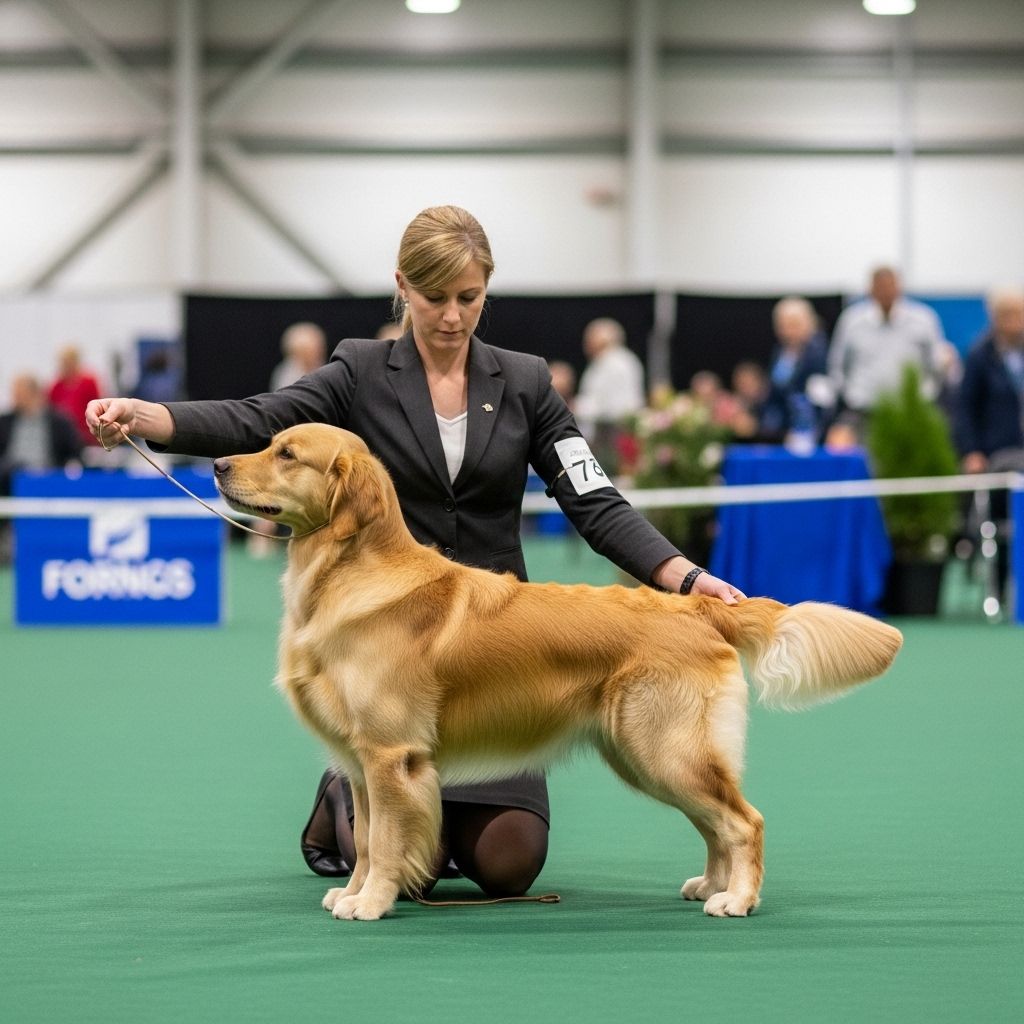How to Get Started in Dog Show Conformation
Master breed standards and ring etiquette to enter the competition with confidence.

Have you ever watched a dog glide around the show ring and wondered what it takes to compete—and perhaps win—at an AKC dog show? Conformation events evaluate purebred dogs against breed standards, considering physical attributes, temperament, and movement. This comprehensive guide covers everything you need to know to get started, from eligibility requirements and entry steps to understanding judging and tapping crucial resources.
What Is Dog Show Conformation?
Conformation is the official term for dog shows that assess how closely a dog aligns with its breed’s written standard. This standard covers:
- Physical appearance and structure
- Temperament
- Movement (known as “gait”)
- Specific physical features such as coat, color, height, weight, tail, and ear placement
The aim is not simply to select the ‘prettiest’ animal, but to evaluate potential breeding stock for responsible breeders and contribute to the future health and type of the breed.
Can Your Dog Compete in Conformation?
To compete in AKC conformation events, your dog must fulfill several eligibility criteria:
- Breed: Must be a recognized AKC breed (AKC recognizes over 200 breeds and varieties)
- Registration: Registered with the American Kennel Club (AKC)—your dog should have an official certificate
- Age: Minimum 6 months old
- Health: Fully vaccinated and free from ‘disqualifying faults’
- Intact: Not spayed or neutered (unless entering certain non-championship events)
Conformation events are about evaluating dogs for future breeding potential, so dogs shown are typically intact and of proven lineage. Mixed breeds, altered dogs, and many rescue dogs are not eligible to compete.
Types of Conformation Dog Shows
There are several types of dog shows and events you might encounter:
- All-Breed Shows: Feature all recognized AKC breeds, often with large entries (over 3,000 dogs at big events)
- Specialty Shows: Focus only on a single breed or closely related breeds
- Group Shows: Feature only breeds from one of the AKC’s seven groups (e.g., Sporting, Herding)
These events may be local or national in scope, and the experience can range from quiet club matches to lively, prestigious competitions like Westminster.
Understanding the Breed Standard
Every recognized breed has a written standard—owned and maintained by its national parent club and approved by the AKC. The standard describes the “ideal” specimen with details on:
- General appearance
- Movement and form
- Size, proportion, and substance
- Temperament
- Coat type and color
- Head shape, ear carriage, eye color
- Feet, tail, and other distinctive traits
Judges match each dog against this ideal. The process is subjective—judges interpret the standard, giving their informed opinion about the best representatives in the ring that day.
Preparing for Your First Show
1. Attend a Show in Person
The best way to understand conformation is to visit one firsthand. When you do:
- Watch dogs in the ring—observe their movement and how they are ‘stacked’ for examination
- Note the calm and focused atmosphere; conformation shows are more about precision and evaluation than excitement
- Feel the camaraderie between exhibitors, spectators, and officials
- See firsthand the role of professional handlers versus owner-handled dogs
This helps you decide if you want to show your dog yourself, or possibly hire a professional handler.
2. Join a Local AKC Club
Connecting with an AKC club provides invaluable resources:
- Training classes for handling and ring presentation
- Mentorship from experienced exhibitors
- Education about rules, etiquette, and breed standards
- Opportunities to volunteer and get familiar with the dog show environment
Many clubs are eager to welcome newcomers and offer support for first-time exhibitors.
3. Study Exhibitor Resources
The AKC website provides essential resources including:
- Beginner’s Guide to Dog Shows
- Step-by-step instructions for entry forms
- Rules and regulations for conformation
- List of upcoming local and national events
Refer to the Exhibitor Resources section regularly as you prepare.
Selecting the Right Dog Show Class
Your dog’s age, status, and experience determine which class you may enter.
| Class Name | Eligibility | Description |
|---|---|---|
| Puppy (6-9 months, 9-12 months) | Breed registered; between ages listed | For young dogs beginning their show careers |
| 12-18 Month | Breed registered; 12–18 months old | For adolescents not yet ready for Open class |
| Bred-By-Exhibitor | Bred and shown by exhibitor | Highlights breeder’s skill |
| American-Bred | Bred in the US | Open to dogs bred in America |
| Open | Any eligible dog of requisite breed | Open to all dogs excluding champions |
Champions of Record compete separately from non-champions. Dogs are eligible for “points” in select classes toward their AKC championship, which requires 15 points including two major wins from three separate judges.
The Judging Process: What to Expect
Judges will examine each dog methodically:
- Evaluate overall appearance, structure, and movement
- Physically check features such as bite, coat, and tail
- Assess temperament and how the dog responds to handling
- Compare to the breed’s written standard for ideal traits
Placements proceed in several rounds:
- Dogs compete against their own sex in classes within a breed
- Class winners go up against other winners (Winners Dog/Bitch)
- Best of winners compete against existing champions in breed
- Breed winners then compete at the group level (among breeds of similar function, e.g., Herding)
- Group winners progress to Best in Show, competing for the highest honor
The process is repeated in every breed and at every conformation event.
How to Enter a Conformation Show
Once you’ve chosen your class, complete an AKC entry form—available online or through the superintendent or show secretary:
- Provide your dog’s registration information
- Select the specific class for entry
- Include owner and handler details
- Submit the form before the official closing date (usually 2–3 weeks prior to the event)
Timely and accurate entry is crucial. Late entries are not accepted by the AKC.
Essential Equipment and Preparation
Preparing for your first show requires planning. Typical equipment includes:
- Non-slip lead and show collar
- Grooming brushes and sprays suited to breed
- Water and treats
- Stool bags and towels
- Travel crate or comfortable containment
Practice in advance with your dog—learning to stack, move smoothly, and accept examination.
Code of Sportsmanship
The AKC emphasizes sportsmanship for all competitors—fairness, respect, and integrity are core values. Read the AKC Code of Sportsmanship before attending your first event to understand proper etiquette and expectations.
Resources for New Exhibitors
- AKC Exhibitor Resources:
- Beginner’s Guide to Dog Shows
- How to complete entry forms
- Count points and track progress
- Rules and regulations
- Conformation calendar: list of events
- Explanation of all-breed and specialty shows
- Frequently Asked Questions
- Breed clubs and parent organizations: Details on breed-specific standards, mentoring, and specialty shows
- Show Superintendents and Secretaries: Operational help and rule clarifications
- AKC Gazette and ‘Weekly Wins’: News and updates
Frequently Asked Questions
Q: Can altered dogs (spayed/neutered) compete?
A: Only intact dogs may compete in championship conformation events, but some non-championship activities (such as performance sports, junior handling, or certain exhibition events) may allow altered dogs.
Q: Do I need to hire a professional handler?
A: Many exhibitors handle their own dogs, especially at the early stages. As competition intensifies, some may choose to hire professional handlers who are experts at presentation and ring craft.
Q: How are dogs grouped for competition?
A: Dogs are placed in one of seven AKC groups: Sporting, Hound, Working, Terrier, Toy, Non-Sporting, and Herding. Breed winners compete within their group, and group winners advance to Best in Show.
Q: What is a ‘major win’?
A: ‘Major wins’ are victories worth three, four, or five points, typically at larger shows and awarded by at least three different judges. Two major wins are required for the AKC Championship.
Q: What happens at the show?
A: Handlers walk their dogs around the ring, present them for examination, and answer any questions the judge may have. The judge may feel and examine each dog, considering physical and temperamental attributes.
Tips for First-Time Exhibitors
- Observe and learn: Attend shows before competing
- Network: Seek mentoring from club members and experienced handlers
- Train: Practice stacking and ring movement with feedback
- Prepare paperwork: Double-check entry forms for accuracy
- Check grooming: Refine grooming to breed standards
- Stay positive: Focus on fun, learning, and your dog’s experience
Quick Glossary
- Conformation: Show judging based on breed standards
- Stack: Dog’s posed stance in the ring
- Handler: Person showing the dog (owner, breeder, or professional)
- Breed Standard: Written “ideal” for each breed
- Best in Show: Event winner selected from all group winners
- Superintendent: Official responsible for event entries and management
Useful Links and Resources
- Official AKC Breed List – Review breeds eligible for conformation
- AKC Beginner’s Guide – Step-by-step info for new exhibitors
- AKC Code of Sportsmanship – Event rules and expected participant conduct
- Parent Breed Clubs – For detailed breed standards, mentoring, events
- Local AKC Club Finder – Find and join a club near you
Frequently Asked Questions
Q: Can puppies compete in conformation?
A: Yes, puppies as young as six months can compete in designated puppy classes, provided they are registered and meet eligibility requirements.
Q: Are rescue dogs eligible?
A: Only purebred, AKC-registered dogs are eligible for conformation events. Some alternative exhibitions may allow mixed breeds and rescues.
Q: What does a handler do?
A: The handler presents the dog in the ring, controlling movement, stacking for examination, and responding to judge’s instructions.
Q: Is there any advantage to joining a breed club?
A: Yes, breed clubs provide extensive mentoring, breed-specific insights, and specialty show opportunities vital for deeper involvement in conformation.
Conclusion
Dog show conformation is a rewarding pursuit built on traditions of responsible breeding, sportsmanship, and respect for canine excellence. With patience, preparation, and learning, new exhibitors can embark on a fulfilling journey, contributing not just to their breed but to the larger dog world. Remember to leverage AKC and club resources, study the breed standards, and focus on your dog’s health, happiness, and presentation as you get started.
References
- https://www.akc.org/sports/conformation/resources/select-conformation-dog-show-class/
- https://fotp.com/learn/dog-training/your-guide-to-conformation-for-kennel-club-dog-shows
- https://www.akc.org/sports/conformation/get-started/
- https://www.akc.org/sports/conformation/resources/
- https://www.westminsterkennelclub.org/dog-shows/
Read full bio of Shinta












